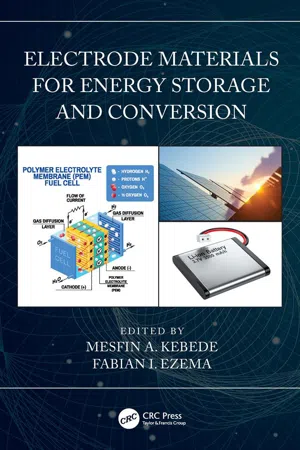
Electrode Materials for Energy Storage and Conversion
Mesfin A. Kebede, Fabian I. Ezema, Mesfin A. Kebede, Fabian I. Ezema
- 498 Seiten
- English
- ePUB (handyfreundlich)
- Über iOS und Android verfügbar
Electrode Materials for Energy Storage and Conversion
Mesfin A. Kebede, Fabian I. Ezema, Mesfin A. Kebede, Fabian I. Ezema
Über dieses Buch
This book provides a comprehensive overview of the latest developments and materials used in electrochemical energy storage and conversion devices, including lithium-ion batteries, sodium-ion batteries, zinc-ion batteries, supercapacitors and conversion materials for solar and fuel cells. Chapters introduce the technologies behind each material, in addition to the fundamental principles of the devices, and their wider impact and contribution to the field. This book will be an ideal reference for researchers and individuals working in industries based on energy storage and conversion technologies across physics, chemistry and engineering.
FEATURES
-
- Edited by established authorities, with chapter contributions from subject-area specialists
-
- Provides a comprehensive review of the field
-
- Up to date with the latest developments and research
Editors
Dr. Mesfin A. Kebede obtained his PhD in Metallurgical Engineering from Inha University, South Korea. He is now a principal research scientist at Energy Centre of Council for Scientific and Industrial Research (CSIR), South Africa. He was previously an assistant professor in the Department of Applied Physics and Materials Science at Hawassa University, Ethiopia. His extensive research experience covers the use of electrode materials for energy storage and energy conversion.
Prof. Fabian I. Ezema is a professor at the University of Nigeria, Nsukka. He obtained his PhD in Physics and Astronomy from University of Nigeria, Nsukka. His research focuses on several areas of materials science with an emphasis on energy applications, specifically electrode materials for energy conversion and storage.
Häufig gestellte Fragen
Information
1 Lithium-Ion Batteries: From the Materials' Perspective
1.1 Introduction
1.2 Brief History of Lithium-Ion Battery Materials
Inhaltsverzeichnis
- Cover
- Half Title
- Title Page
- Copyright Page
- Contents
- Foreword
- Preface
- Editors
- Contributors
- Chapter 1 Lithium-Ion Batteries: From the Materials’ Perspective
- Chapter 2 Carbon Derivatives in Performance Improvement of Lithium-Ion Battery Electrodes
- Chapter 3 Current Status and Trends in Spinel Cathode Materials for Lithium-Ion Battery
- Chapter 4 Zinc Anode in Hydrodynamically Enhanced Aqueous Battery Systems
- Chapter 5 Advanced Materials for Energy Storage Devices
- Chapter 6 Li6PS5X (X = Cl, Br, or I): A Family of Li-Rich Inorganic Solid Electrolytes for All-Solid-State Battery
- Chapter 7 Recent Advances in Usage of Cobalt Oxide Nanomaterials as Electrode Material for Supercapacitors
- Chapter 8 Recent Developments in Metal Ferrite Materials for Supercapacitor Applications
- Chapter 9 Advances in Nickel-Derived Metal-Organic Framework-Based Electrodes for High-Performance Supercapacitor
- Chapter 10 The Place of Biomass-Based Electrode Materials in Next-Generation Energy Conversion and Storage
- Chapter 11 Synthesis and Electrochemical Properties of Graphene
- Chapter 12 Dual Performance of Fuel Cells as Efficient Energy Harvesting and Storage Systems
- Chapter 13 The Potential Role of Electrocatalysts in Electrofuels Generation and Fuel Cell Application
- Chapter 14 Reliability Study of Solar Photovoltaic Systems for Long-Term Use
- Chapter 15 Physical Methods to Fabricate TiO2 QDs for Optoelectronics Applications
- Chapter 16 Chemical Spray Pyrolysis Method to Fabricate CdO Thin Films for TCO Applications
- Chapter 17 Photovoltaic Characteristics and Applications
- Chapter 18 Comparative Study of Different Dopants on the Structural and Optical Properties of Chemically Deposited Antimony Sulphide Thin Films
- Chapter 19 Research Progress in Synthesis and Electrochemical Performance of Bismuth Oxide
- Chapter 20 Earth-Abundant Materials for Solar Cell Applications
- Chapter 21 New Perovskite Materials for Solar Cell Applications
- Chapter 22 The Application of Carbon and Graphene Quantum Dots to Emerging Optoelectronic Devices
- Chapter 23 Solar Cell Technology: Challenges and Progress
- Chapter 24 Stannate Materials for Solar Energy Applications
- Index